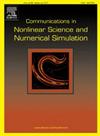Regularity and strong convergence of numerical approximations for stochastic wave equations with multiplicative fractional Brownian motions
IF 3.8
2区 数学
Q1 MATHEMATICS, APPLIED
Communications in Nonlinear Science and Numerical Simulation
Pub Date : 2025-02-06
DOI:10.1016/j.cnsns.2025.108648
引用次数: 0
Abstract
Stochastic wave equations with multiplicative fractional Brownian motions (fBms) provide a competitive means to describe wave propagation process driven by inner fractional noise. However, regularity theory and approximate solutions of such equations is still an unsolved problem until now. In this paper, we achieve some progress on the regularity and strong convergence of numerical approximations for a class of semilinear stochastic wave equations with multiplicative fBms. Firstly, we impose some suitable assumptions on the nonlinear term multiplied by fBms and its Malliavin derivatives, and analyze the temporal and spatial regularity of stochastic convolution operator under the assumptions for two cases and . Using the obtained regularity results of the stochastic convolution operator, we further establish the regularity theory of mild solution of the equation, and reveal quantitatively the influence of Hurst parameter on the regularity of the mild solution. Besides that, we give a fully discrete scheme for the stochastic wave equation and analyze its strong convergence. Finally, two numerical examples are carried out to verify the theoretical findings.
具有乘法分数布朗运动的随机波动方程数值近似的正则性和强收敛性
具有乘法分数布朗运动(fBms)的随机波动方程提供了一种有竞争力的方法来描述由内分数噪声驱动的波动传播过程。然而,这类方程的正则性理论和近似解至今仍是一个未解决的问题。本文研究了一类具有乘性fBms的半线性随机波动方程数值逼近的正则性和强收敛性。首先,对乘上fBms的非线性项及其Malliavin导数进行了适当的假设,分析了H∈(0,1/2)和H∈(1/2,1)两种情况下随机卷积算子的时空正则性。利用得到的随机卷积算子的正则性结果,进一步建立了方程温和解的正则性理论,并定量地揭示了Hurst参数对温和解正则性的影响。此外,给出了随机波动方程的完全离散格式,并分析了它的强收敛性。最后,通过两个数值算例验证了理论结果。
本文章由计算机程序翻译,如有差异,请以英文原文为准。
求助全文
约1分钟内获得全文
求助全文
来源期刊

Communications in Nonlinear Science and Numerical Simulation
MATHEMATICS, APPLIED-MATHEMATICS, INTERDISCIPLINARY APPLICATIONS
CiteScore
6.80
自引率
7.70%
发文量
378
审稿时长
78 days
期刊介绍:
The journal publishes original research findings on experimental observation, mathematical modeling, theoretical analysis and numerical simulation, for more accurate description, better prediction or novel application, of nonlinear phenomena in science and engineering. It offers a venue for researchers to make rapid exchange of ideas and techniques in nonlinear science and complexity.
The submission of manuscripts with cross-disciplinary approaches in nonlinear science and complexity is particularly encouraged.
Topics of interest:
Nonlinear differential or delay equations, Lie group analysis and asymptotic methods, Discontinuous systems, Fractals, Fractional calculus and dynamics, Nonlinear effects in quantum mechanics, Nonlinear stochastic processes, Experimental nonlinear science, Time-series and signal analysis, Computational methods and simulations in nonlinear science and engineering, Control of dynamical systems, Synchronization, Lyapunov analysis, High-dimensional chaos and turbulence, Chaos in Hamiltonian systems, Integrable systems and solitons, Collective behavior in many-body systems, Biological physics and networks, Nonlinear mechanical systems, Complex systems and complexity.
No length limitation for contributions is set, but only concisely written manuscripts are published. Brief papers are published on the basis of Rapid Communications. Discussions of previously published papers are welcome.
 求助内容:
求助内容: 应助结果提醒方式:
应助结果提醒方式:


